2013 Gloucester Schooner Races
A Personal Account
Lunenburg and schooner Bluenose II
When Nancy and I revisited Nova Scotia two years ago, we concentrated our stay around Mahone Bay, the "Ocean Playground" of Canada. Yes, you guessed it, I had my sea canoe on the car roof rack and had already planned several day trips between Chester and Lunenburg, around as many of the 365 islands as possible. In 2004 I had only sped through this area on my way around the entire province of Nova Scotia, but now I was going to look into all those enticing side trips one always sees when being on a straight-line trip.
I could hardly wait to get there. My trips were just as exciting as envisioned, each mostly around a dozen islands and several headlands. The weather was great too, as predicted by the Canadian Sailing Directions, the boater's bible, as well as mine: "During fogs, which are frequent in July and August, the SW shore of Mahone Bay is usually clear with winds west of south."
I had a ball. But the most significant moment came on our visit to Lunenburg, the old fishing port and home port of the famous schooner Bluenose and its replica Bluenose II, the icon of Nova Scotia. It even made it onto the Canadian dime, commemorating its many race victories against the schooners from America's biggest fishing port, Gloucester, Massachusetts. And it so happened, we were able to walk right into the huge construction shed where Bluenose II was being rebuilt. At that time it was being re-planked. Nancy and I, in hard-hats, breathed in the pungent wood smell of the heavy oak timbers, and marveled at the seemingly choreographed dance of the many workers doing their specific jobs. And yes, it was very loud without ear-plugs.
The Lunenburg-Gloucester rivalry
And I thought to myself, how much fun it must have been to sail in those races or at least to watch them from another boat or from shore, like from Peggy's Cove – and I started reading about it. Both ports (Lunenburg and Gloucester) still celebrate windjammer days, parades and open-house on board, but Gloucester, I found out, still hosts schooner races on Labor Day weekend each year, the high point of that old fishing port. Schooners of all sizes from up and down the Atlantic coast gather off East Point, outside the breakwater, for friendly but fiercely competitive races, just like in the heyday of the Grand Banks fishing schooners Bluenose and Esperanto.

Esperanto
And since I know this area very well from participating in the 22-mile Blackburn Challenge around Cape Ann (the bigger Gloucester area, that is) in my solo outrigger canoe for the past 12 years, I now also wanted to be part of the schooner races. There are 3 classes, according to length on deck, the largest schooners over 80 feet racing for the Esperanto Cup (named for the first winning boat). And I immediately knew which boat I wanted to be on: the 92 foot schooner American Eagle, built in 1930 in Gloucester, then, since 1984, owned, restored and skippered by John Foss, out of Rockland, Maine.

American Eagle
Meeting Gloucester-built American Eagle in Maine waters
I had met that boat anchored off Stonington, Maine in 2006, when I paddled the newly extended "Maine Island Trail" from Cape Porpoise (near Kennebunkport) to Machias. I stopped, took pictures of the beautifully maintained boat gleaming in the early rays of the rising sun, when suddenly a bucket was lowered over the side, holding a piece of apple pie with a fork – a first in all my thousands of miles of paddling along the shores of New England and the Maritimes. Thanks, Capt. Foss!

American Eagle off Stonington, 2006
I promised the skipper I would sail with him some time. Well, 2013 was finally the right time. Sailing down to the races in Gloucester, Massachusetts from Rockland, Maine also appealed to me: a real trip with a purpose. It would include some off-shore and even night sailing, something I could not do in my 17' solo sea canoe. I then read that Skipper John had won the race 9 times already. Being a competitive boater, I smiled from ear to ear, and could hardly wait to try my best to help win a tenth time for boat and Skipper.
I had sailed on a 45' schooner across the Atlantic from Camden, Maine to St. Malo, France (as watch captain, in charge of wood and canvas), and in 2011 I sailed on a 75-year old classic 60' yawl from Antigua, Caribbean diagonally across the Atlantic, to Hamburg, Germany. So I still had my sea legs, and was eager to help the American Eagle crew of three whenever I could and was needed.
Off to the races
On August 28, 2013, at 6:00 p.m., we 26 passengers, each with varied sailing experience, boarded the 92' schooner. We met Skipper John Foss and deck crew of three competent young men, led by first mate John (another John), as well as cook Andy and his assistant. Nancy came along to see me off and even tried out my tight but cozy little upper bunk in cabin J. Everything looked just right and just as I had expected. The wood-paneled galley even had an old-fashioned woodstove to cook the meals on, bake bread, muffins and pies, as well as radiate welcome heat on cold, foggy mornings, of which we had quite a number.

Author boarding American Eagle in Rockland, Maine
Early next morning we motored off our dock, set foresail, jib and staysail (which I would have called the "jumbo") and motor-sailed practically all day, since the wind was light and flukey, and we had to get to Portland, the half-way point to Gloucester. Today's scenery looked very familiar to me, since I had sailed and paddled this stretch many times before: down Mussel Ridge Channel (spelling according to DeLorme maps, but Muscle Ridge Channel on nautical charts), past Mosquito Head/Port Clyde, inside of Monhegan I., but outside of Seguin I., and finally into Casco Bay via the Whitehead Passage to our anchorage off Peaks/ Great Diamond/House Island.
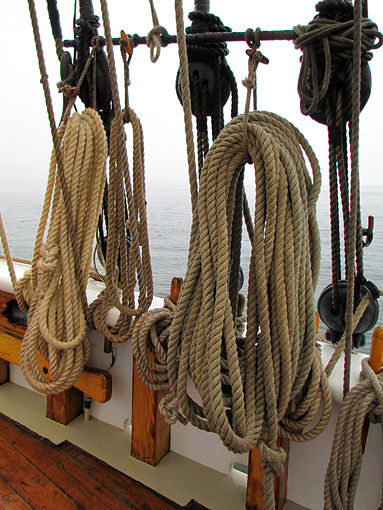
Re-learning the ropes
Two passengers were already so seasick that they requested to be rowed ashore on Peaks I., from whence they would take the ferry boat back to Portland (and then on to their home). They missed a great chicken dinner and strawberry shortcake with whipped cream for dessert. The passengers turned out to be a very jovial, interesting group of people, some couples, some solos, some first-timers, but also several who had sailed on this boat many times before. I had very interesting and varied conversations with almost everyone, had a good time and felt very comfortable, even in our close quarters. Since I normally travel solo on my ocean trips, this was a true vacation: I did not have to make decisions, plot courses, take care of boat, gear, food etc., just be safe, fit in, help out and have fun. Not a bad way to travel!

Skipper at the helm

Young crew of three on the fore-deck
We motored off anchor at 7:15 a.m., even before breakfast, which was then served on deck off scenic Portland Head Light. After rounding Cape Elizabeth, we more or less straight-lined it to Gloucester. I could barely make out the Isles of Shoals (off Portsmouth, New Hampshire). We were suddenly off-shore. It could have been the middle of the Atlantic. Only a few gannets and porpoises reminded us that land was still near by. We were surrounded by a wrap-around horizon. On one hand it felt as if we were the center of an immense universe, on the other hand nothing more than a minute speck in an endless world. A great but also humbling feeling, which always gets to me, when I sail or paddle off shore or in dense fog.
Arrival in Gloucester
Then suddenly the dual lighthouses on Thatcher I./Cape Ann appeared in the distance, the abandoned N tower and the still active, 166' high S Tower. This is very familiar territory for me, from my 12 annual solo outrigger races around Cape Ann. From here I knew it was 11 more miles to the finish line in Gloucester Harbor, a hard pull, which I, however, never mind, since I seem to do better here than on the first 11 miles. We finally dropped anchor in the outer harbor off Niles Beach and Ten Pound Island, well fortified and happily satiated with a scrumptious dinner of pork loin with applesauce, rolls, salad and fruit, just as the sun was setting in the west with a golden glow. Wow! This schooner fare certainly beats my trip suppers of Bush baked beans, Hormel chili, Dinty Moore beef or chicken stew or canned spaghetti with meatballs.

Passengers helping out...

...waiting for the next meal...

...resting after that meal
It was another foggy night, but right after breakfast Skipper asked whether I would like to try out the sporty looking, red skiff Roscoe. It was an absolute joy to row this sleek little boat around the outer anchorage. My cabin mate Roger also had a chance to try it out. After I had signed up on American Eagle, and had read Roger's article about the 2012 Blackburn race (see Messing About in Boats, Nov. 2012; note: "Ragnar" being Reinhard/me), I had mentioned the schooner race to him. He was one of my fiercest competitors in the Blackburn outrigger class, but I decided to suggest to him that rather than beating up on each other year after year, we should try joining forces and help win one for the "gipper", or better the skipper and schooner American Eagle, the most successful schooner in the big-boat class, to make it an even TEN wins for Capt. Foss. A day or two later, Roger signed on, even though we had never even talked to each other before. So now we were sharing a tiny cabin with upper and lower bunks – me in the upper, as usual.

A-OK in the top bunk
When approaching the Gloucester breakwater, Roger was talking about the Blackburn race, and other passengers asked: "So who won?" I was not going to mention it, but Roger graciously acknowledged that I had now beaten him three years in a row. I have to say, though, that wasn't easy: Roger is nine years younger than I am, and a very experienced, competitive, strong, fast paddler.
After breakfast and weighing anchor, Skipper Foss took his American Eagle outside the breakwater to have us all practice for tomorrow's race. The weather was again not the best. There was some rain, some lightning and variable winds, barely up to 10 knots. But we met up with our competition: the slender, high-sided and very fast Virginia, who had beaten our boat by a few seconds in the past, while in other years it was the other way around. And then there were the two schooners Adventure and Roseway, formerly owned and skippered by Jim Sharp, and last but not least, Boston's sluggish looking Liberty Clipper . (It was Adventure's first race after a lengthy overhaul in Gloucester, its new home port, and townspeople were eagerly cheering her on.)
Everybody was watching everybody else. We were speed testing against Virginia, who was sporting her topsails and flying jib, neither of which we had. But our mainsail was massive and brand new; so was the foresail. We were able to keep up with our competition and felt good. Then the wind dropped off and we enjoyed a delicious lunch of left-overs, spruced up with an avocado and tomato salad and chocolate brownies.
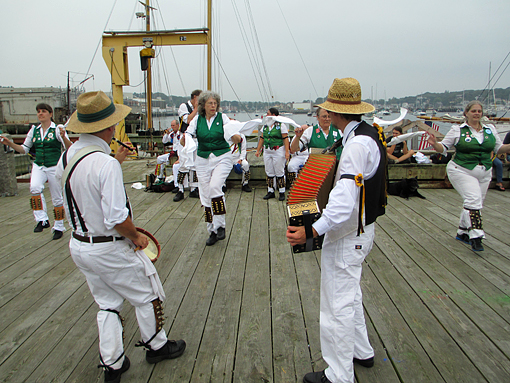
Morris dancers in Gloucester
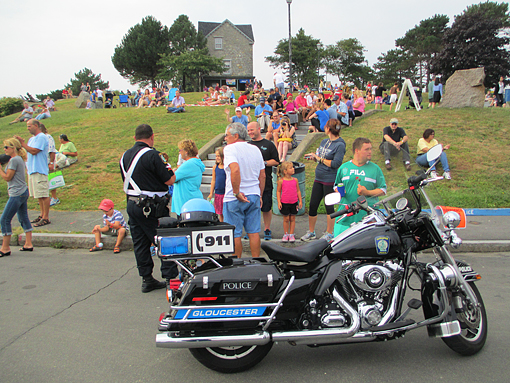
Gloucester spectators enjoying a lobster meal and music
We motored into the inner harbor and tied up at the Maritime Gloucester dock. Soon thereafter, Virginia and Roseway tied up alongside. So there was quite some people-traffic on board. On the pier a group of Morris dancers, accompanied by squeezebox, fife and drums, was showing off their stuff. I listened to a quintet of two guitars, string bass, fiddle and mandolin playing Irish songs and chanteys in the style of the Irish Rovers of the seventies, while people were enjoying a lobster meal on the grassy slopes of the park across the street. I then walked as far as the Fisherman's Memorial at the harbor promenade, and, returning to the boat, just caught a glimpse of Skipper rowing off in the little red dinghy with a big galvanized tub to fetch lobsters for tonight's pre-race dinner.

Skipper fetching lobsters for our pre-race feast
While I am normally a modest eater and always stop after one lobster, this time I did not. There also was some wine on board which washed down the seafood just fine, leaving just enough room for blueberry pie for dessert. Nice energy and motivation to do well in the race tomorrow, I thought to myself, as we joined chantey singer Peter Souza, harmonizing, when we did not know the words. Then the parade of lights (smaller boats) passed by us, and a tad later we all enjoyed significant fireworks, which were set off from a barge off the promenade. A memorable evening indeed. The night was loud, but ear-plugs took care of excessive noise, and I soon dozed off.
Schooner parade and the race

Off to the parade
In the morning we had to wait for guests to board the Roseway and Virginia as well as our schooner, before we could shove off and join the boat parade past the Fisherman's Memorial at the flag-studded promenade. Motors kept most of the schooners and other sailboats in check. There were smaller sailboats and motorboats galore, but also a pod of old-fashioned fishing dories filled with eager, brightly clad young Gloucester rowers, as well as several traditional 6-8 person rowing gigs and a myriad of sea kayaks. The press was out in their own boat, sporting high-powered telephoto lenses, and describing the event in very important-sounding Tom-Brokaw-like voices.

Virginia, Roseway & Adventure during the parade of sails

Young dory-rowers at the parade
Being one of the 5 biggest schooners, which do not turn too well in tight spaces, we soon headed out to the starting line, where at 1:00 p.m sharp the first gun went off: 10 minutes to the start. The wind was still light, about 10 knots, but our skipper managed to position American Eagle next to the committee boat on the starboard end of the starting line so that we would sail off on starboard and have right of way over the entire fleet of 19 schooners. The timing was perfect for a big boat in light winds. Well done, Skipper! I also felt the new wind was coming in over starboard. So I definitely felt this was the right tack to take. After 30 minutes, though, the wind shifted to port and favored Adventure,Virginia and Roseway. Liberty Clipper was completely out of the race, since it just did not have the speed like the rest of the boats.
The medium-sized schooner Adirondack rounded the mark first. We were close behind. Virginia over-stood the mark by a long shot and lost the race right there, as I saw it, allowing Adventure to pass her. From the turning mark it was almost a dead down-wind hitch to the finish line. To my surprise, most schooners sailed wung out, i.e. they had one boom to port and one to starboard, allowing jib and jumbo/staysail to luff in the wind shadow behind those huge sails. After having recently raced on my son's fast trimaran, I would have thought that tacking down-wind, allowing all sails to draw fully, would have been faster. But what do I know?

The finish line: "We did it!"
It did not matter, as long as we stayed ahead of Adventure and our arch-rival Virginia. Roseway looked pretty with her russet sails, but only came in fourth. The town of Gloucester was elated to see their schooner Adventure come in a close second, only 3:42 minutes behind us, and beating Virginia by a scant 34 seconds. Adventure was well sailed, and I wondered whether its former skipper Jim Sharp was on board as an adviser – which he was, as I found out at the awards ceremony. I congratulated him, as I knew him from his Camden days. And, yes, this wonderful, wild and very skilled skipper did put in his two cents worth. (Check him out in his book: "With Wild Abandon", a title characterizing him to a T. By the way, Capt. Sharp also was John Foss's mentor and first boss on this very windjammer, the Adventure).

Star of the day: local schooner Adventure, rounding the breakwater
Following an old but harsh sailing tradition, our first-mate John hoisted a broom to the top of the mast, suggesting this boat swept the entire field – well, at least the large schooner class (over 80'), in the Esperanto Cup race. However, line honors were earned by the small schooner (19'-45') Tillicum 1, closely followed by the two medium-sized schooners (45'-80') Tyrone and Brilliant. We came in fourth overall.

Hoisting the broom
Loud, hearty "Hip-hip-hurrays" were shouted across the waters, and singers Peter and his wife Audi (who had joined us on board for the race) got us started again singing chanteys on our way back into the inner harbor. It was a very joyful time, none more so than for Skipper John Foss who had herewith won his tenth race with his boat, the American Eagle. What a feat! And everybody on board was very proud of him and his boat. I know I was.
Supper, including libations, was served on shore under a big tent on the Maritime Gloucester pier. Skippers and crew were exchanging their stories of how the race went. Everybody was then very jovial and gracious, accepting their respective trophy with a short speech.

Skipper John Foss accepting the Esperanto Trophy
Homeward bound
But for us, the celebration ended right here. We went back on board and got ready for a night sail "downeast", back to Rockland, Maine. Yes, it was here that the term "downeast" originated. Boston schooners would often sail "downwind" (wind from behind) before a prevailing SW wind, in a northeasterly direction. If you then add the almost 20° western variation to your compass course, you would end up steering almost due east on your compass, therefore the term "downeast", down wind to the east.
Roger and I hit our bunks almost immediately, since we had signed up for the 2:00-4:00 a.m. night bow-watch. It was foggy, real foggy, and the sky was full of heat lightning, as we strained our eyes and ears to make out other boats. We were about 23 miles off shore, off the Isles of Shoals, as we came on deck. The wind came out of the NE, and the sea was very lumpy and confused at first, eventually straightening out in the new NE wind. We stuck the long bowsprit in the water as our trusty engine, fore and staysail pushed us along at our usual 6-7 knot speed, but we soon reduced speed to 4.5 knots for a gentler ride.
We heard or saw no other boat, encountered no iceberg either, as I jokingly added to our report when the next watch came on deck. We eventually ducked behind Allen Island into Davis Strait and straight past picturesque Marshall Point Light into Port Clyde, still in thick fog. We dropped anchor near the ferry dock to Monhegan Island. Then the rains came down. We had a subdued lunch under extra awnings on deck or the galley below, and when the rain finally stopped, we rowed ashore in our big 11-person rowboat.
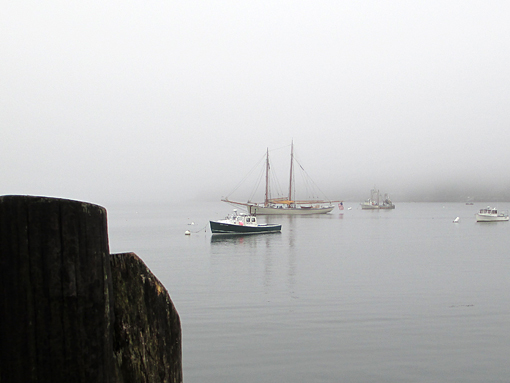
Foggy anchorage in Port Clyde, ME
I went too, but there was absolutely nothing for me to do or see in Port Clyde, other than watch the ferry boat leave, and stroll through the only store in town, which also has a food counter and bar, as well as a large picture gallery upstairs. I looked at various Winslow Homer pictures, especially one entitled "Gloucester Schooners", and paintings by Andrew Wyeth, the other famous painter from this neck of the woods. However, I had to tell the clerk that the title of one picture was "Christine's World" and not "Christine World" as the label indicated. The rain and fog were finally getting to me; I felt a bit irritated and punchy, and could not wait to get back on board for a hot cup of coffee, some reading and jotting down notes, bringing my trip log up to date. A grand supper of roast beef and hand-cranked ice cream lifted everybody's spirits. Thanks, Andy! I needed that.
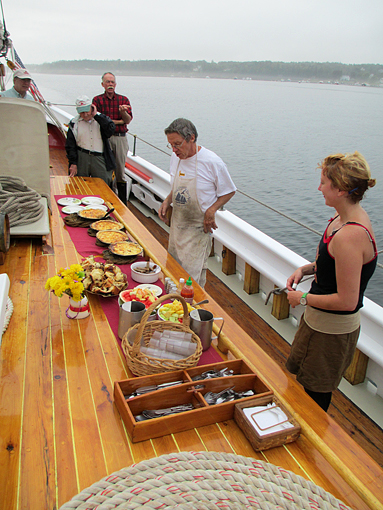
Last meal on board: breakfast of quiche off Owl's Head Light
It was another cold, rainy and foggy night, but we were off again before breakfast. We felt our way around Mosquito I. and into Mussel/Muscle Ridge Channel towards Owl's Head Light, where we cut engine and had breakfast on deck. We had planned to dock back in Rockland at 10:30. a.m. (and we did). I had called Nancy on my vintage 2001 (or older? Since I bought it refurbished) Iridium satellite phone, which crew and guests facetiously/humorously called my "shoe-phone", as in the 1960s TV series "Get Smart". (Well, it may look almost as big as a shoe to modern cell-phone users, but hey, it still works.) And there she was on the dock in Rockland: Nancy, even with our son Lee, to greet us and check out the winning boat.

Heading into homeport, Rockland
End of trip
Then suddenly everything went very fast. We took a group picture, packed our things, exchanged addresses, shook hands all around, and in no time the boat and even the dock were empty. The crew picked up our bags of dirty linen, collected the trash, pumped out the holding tank, and already started working for the next trip, a shorter 4-day loop around Penobscot Bay, starting tomorrow morning.
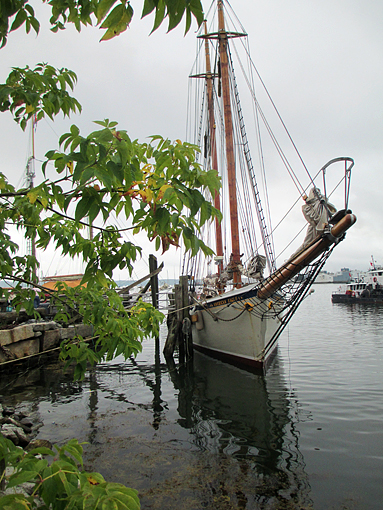
Trip over
While I was telling Nancy and Lee about our trip to Gloucester and the race, on our way home to Orono, it slowly dawned on me what a significant trip it had been. OK, the weather could have been better, the wind a bit stronger for the race, but those are factors one cannot change. All in all, it was a very memorable and successful 7-day trip on a classic, 83-year-old 92' fishing schooner, which had just won its tenth Esperanto Cup race in its birthplace, Gloucester, the oldest fishing port in the USA. I was pleased and proud to have been part of it.
"Hip-hip-hurray to the American Eagle and her Skipper!"
Notes:
The 92' Schooner American Eagle was launched in 1930 as the Andrew & Rosalie, the last fishing schooner built in Gloucester. She was renamed American Eagle in 1941. She made her last fishing trip in 1983 and was then sold to Capt. John Foss and towed to Rockland, Maine for rebuilding as a vacation windjammer for 26 passengers and a crew of 6, including skipper. After a complete rebuild, she was relaunched in 1986 and has since sailed mostly in Maine waters, but also participated in numerous Opsail events in New York, Boston and Lunenburg, Nova Scotia, Canada. In 1991 she was designated a National Historic Landmark.
The trip down to her "birthplace", Gloucester, for the traditional Labor Day schooner festival and races, has become a long-standing tradition and the highlight of each sailing summer. This year's win in the big boat class, the Esperanto Cup Race, was the American Eagle's tenth win for boat and Skipper John Foss.
For more info on boat and trip schedule, check out: www.schooneramericaneagle.com
The Esperanto Cup Race was named after the 107' schooner Esperanto. She was designed by Boston's famous naval architect Tom McManus and built in Essex, Massachusetts in 1906. She was named for the international language Esperanto, an "easy to learn, political neutral language that would transcend nationality and foster peace and international understanding," according to my Wikipedia source. It is based on L.L. Zamenhof's 1887 book Unua Libro.
In 1920, America's Esperanto was the first winner in the International Fishing Vessel Championship, a match-race of sorts (like the America's Cup Races) between the boats of the two greatest fishing ports in the United States and Canada: Gloucester and Lunenburg. Delawana's loss in this first race prompted Canada to design and build the famous Bluenose. However, just months after Esperanto's win, she struck the wreck of the schooner State of Virginia (have I also heard that name before?) off Sable Island, Nova Scotia and sank. So in 1921 Esperanto obviously could not defend her title, and the brand new 143' Bluenose trounced the Gloucester boat Elsie and many more great Grand Banks schooners out of Gloucester thereafter.
But Esperanto's fame of being the first winner of that series lives on today, as we have just experienced. Maybe some day the newly refurbished Bluenose II will find her way back down to Gloucester and revive the old rivalry. It is never too late. What a sight that would be! If that ever happens, I will certainly be back on American Eagle, pulling, tweaking and cajoling our dear old Maine windjammer on to yet another victory, because she might need it against the newly rebuilt speedster Bluenose II. :-)
Till then, happy sailing, my friends.
Be safe, stay out of trouble and enjoy.
************************
![]()
Click here for a printable version of this article
© Reinhard Zollitsch
BACK TO TOP OF PAGE